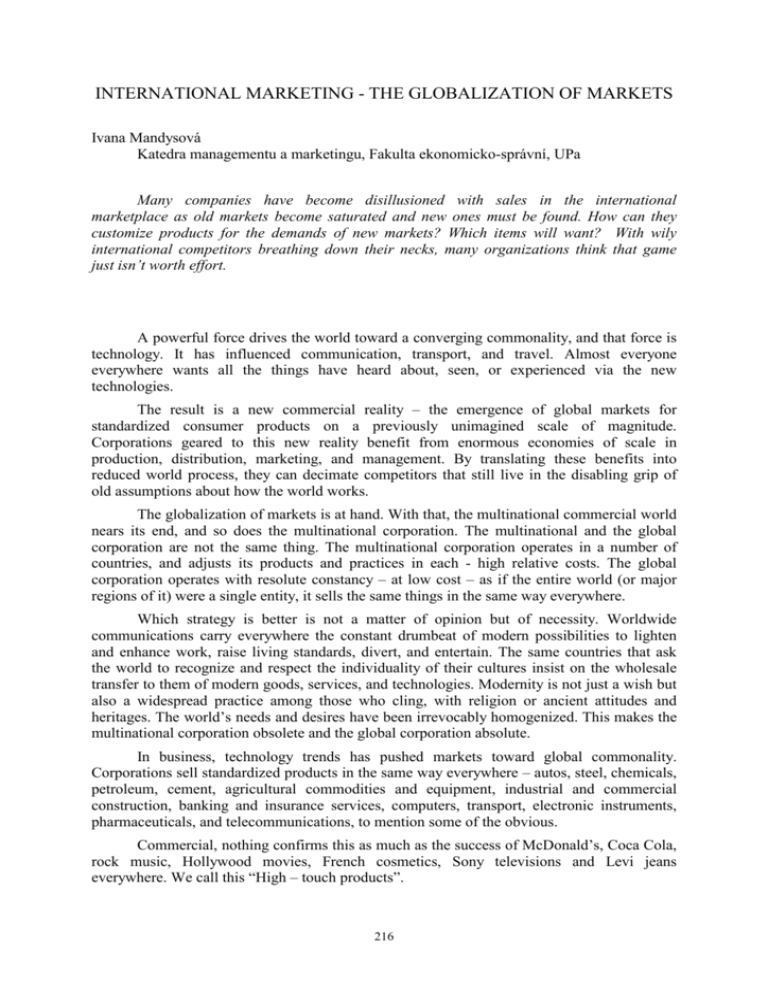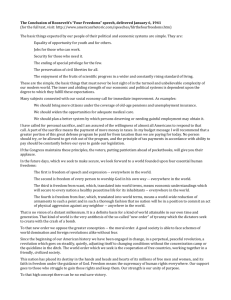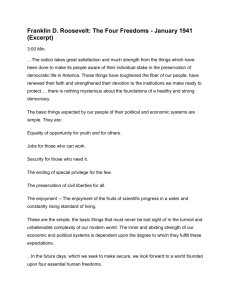International marketing - The globalization of markets
advertisement

INTERNATIONAL MARKETING - THE GLOBALIZATION OF MARKETS Ivana Mandysová Katedra managementu a marketingu, Fakulta ekonomicko-správní, UPa Many companies have become disillusioned with sales in the international marketplace as old markets become saturated and new ones must be found. How can they customize products for the demands of new markets? Which items will want? With wily international competitors breathing down their necks, many organizations think that game just isn’t worth effort. A powerful force drives the world toward a converging commonality, and that force is technology. It has influenced communication, transport, and travel. Almost everyone everywhere wants all the things have heard about, seen, or experienced via the new technologies. The result is a new commercial reality – the emergence of global markets for standardized consumer products on a previously unimagined scale of magnitude. Corporations geared to this new reality benefit from enormous economies of scale in production, distribution, marketing, and management. By translating these benefits into reduced world process, they can decimate competitors that still live in the disabling grip of old assumptions about how the world works. The globalization of markets is at hand. With that, the multinational commercial world nears its end, and so does the multinational corporation. The multinational and the global corporation are not the same thing. The multinational corporation operates in a number of countries, and adjusts its products and practices in each - high relative costs. The global corporation operates with resolute constancy – at low cost – as if the entire world (or major regions of it) were a single entity, it sells the same things in the same way everywhere. Which strategy is better is not a matter of opinion but of necessity. Worldwide communications carry everywhere the constant drumbeat of modern possibilities to lighten and enhance work, raise living standards, divert, and entertain. The same countries that ask the world to recognize and respect the individuality of their cultures insist on the wholesale transfer to them of modern goods, services, and technologies. Modernity is not just a wish but also a widespread practice among those who cling, with religion or ancient attitudes and heritages. The world’s needs and desires have been irrevocably homogenized. This makes the multinational corporation obsolete and the global corporation absolute. In business, technology trends has pushed markets toward global commonality. Corporations sell standardized products in the same way everywhere – autos, steel, chemicals, petroleum, cement, agricultural commodities and equipment, industrial and commercial construction, banking and insurance services, computers, transport, electronic instruments, pharmaceuticals, and telecommunications, to mention some of the obvious. Commercial, nothing confirms this as much as the success of McDonald’s, Coca Cola, rock music, Hollywood movies, French cosmetics, Sony televisions and Levi jeans everywhere. We call this “High – touch products”. 216 No one is exempt and nothing can stop the process. Everywhere everything gets more and more like everything else as the world’s preference structure is homogenized. Consider the cases of Coca-Cola and Pepsi-Cola, which are globally standardized products sold everywhere and welcomed by everyone. Both successfully cross multitudes of national, regional, and ethnic taste buds trained to a variety of deeply ingrained local preferences of taste, flavor, consistency, effervescence, and aftertaste. Everywhere both sell well. They exemplify a general drift toward the homogenization of the world and how companies distribute, finance, and price products. Nothing is exempt. The products and methods of the industrialized world play a single tune for all the world, and all the world eagerly dances to it. Ancient differences in national tastes or modes of doing business disappear. The commonality of preference leads inescapably to the standardization of products, manufacturing, and the institutions of trade and commerce. Success in world competition turns on efficiency in production, distribution, marketing, and management, and inevitably becomes focused on price. The most effective world competitors incorporate superior quality and reliability into their cost structures, They sell in all national markets the same kind of products sold at home or in their largest export market. The compete on the basis of appropriate value – the best combinations of price, quality, reliability, and delivery for products that are globally identical with respect to design, function, and even fashion. If a company forces costs and prices down and pushes quality and reliability up – while maintaining reasonable concern for suitability – customers will prefer its world – standardized products. Of course, large companies operating in a single nation or even a single city don’t standardize everything they make sell or do. Such a search works because a market segment in one country is seldom unique, it has close cousins everywhere precisely because technology has homogenized the globe. Even small local segments have their global equivalents everywhere and become subject to global competition, especially on price. The global competitor will seek constantly to standardize his offering everywhere. He will turn from this standardization only after exhausting all possibilities to retain, and he will push for reinstatement of standardization whenever digression and divergence have occurred. He will never assume that the customer is a king who knows his own wishes. With transportation costs proportionately low, distant competitors will enter the nowsheltered markets of those companies with goods produces more cheaply under scale-efficient conditions. Global competition spells the end of domestic territoriality, no matter how diminutive the territory may be. When the global producer offers his lower costs internationally, his patronage expands exponentially. He not only reaches into distant markets, but also attracts customers who previously held to local preferences and now capitulate to the attractions of lesser prices. The strategy of standardization not only responds to worldwide homogenized markets but also expands those markets with aggressive low pricing. The new technological development accelerates an ancient motivation – to make one’s money go as far as possible. This is universal – not simply a motivation but actually a need. 217 Použitá literatura a prameny: [1] Buzzell, R.: Can You Standardize Multinational Marketing?, Journal of marketing [2] Kotler Philip: Marketing management, Victoria Publishing,1995 research, January 1999 [3] Porter, Michael: Competitive Strategy, Techniques for Analyzing Industries and Competitors, New York 1980 Kontaktní adresa: Ing.Ivana Mandysová, Katedra managementu a marketingu, Fakulta ekonomicko-správní, Univerzita Pardubice, Studentská 84, 532 10 Pardubice ! 040-603 6304 e-mail: Ivana.Mandysova@upce.cz Recenzoval: doc.Dr.Ing.M.Siegl,CSc., KMM, FES, UPa 218











